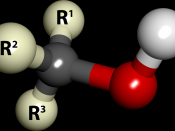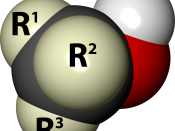Alcohols
Introduction
Alcohols are a group of compounds which have a hydroxyl group joined to either an alkyl group or a cycloalkyl group. A hydroxyl group is an OH joined to a carbon atom and a cycloalkyl group is a ring of six carbon atoms that is arranged in a hexagonal shape.
Naming alcohols
Naming alcohols is not difficult. Basically, you identify the longest chain of carbon atoms. Then you take the name of the 'alkane' or 'alkene' (as if the hydroxyl group weren't there). Taking the name of the 'alkane' or 'alkene', you add to the end of the name the 'position numbers' of the carbon atoms to which the hydroxyl groups are attached to, using commas to separate the different numbers. Then, you add the suffix -ol, which is the suffix of all alcohols. If there are more than one hydroxyl group present, then -di or -tri, and so on, is put just before the suffix -ol.
Homologous series
A homologous series is a group of compounds which have a certain pattern in their structures, therefore have similar chemical properties and a trend in physical properties. The alcohol is one such homologous series. Increasing the chain length causes an increase in boiling and melting points. This is due to the fact that as the molecule increases in chain length, each molecule has larger temporary dipole-dipole interactions, causing larger Van de Waal's forces per molecule. Therefore, more energy is needed to break these increased Van de Waal's forces, hence the increase in boiling and melting points. An increase in chain length also causes the solubility in water to decrease. This is due to the fact that only the hydroxyl group causes the molecule to have an overall dipole. The rest of the molecule remains non-polar. Therefore, as you increase...


